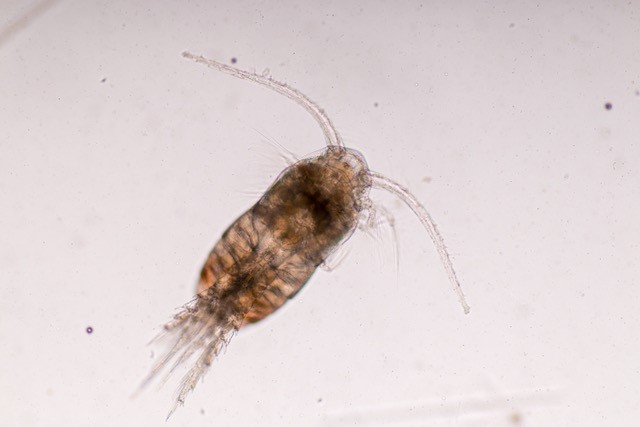
Copepods are small aquatic crustaceans which inhabit a vast range of salinities from fresh water to hypersaline conditions. They are found all over the planet in virtually all bodies of water so, naturally they form a significant foundation of the aquatic food web. For many fish, copepods are the preferred food source and some will feed almost exclusively on them such as the Mandarin fish. For most other fish, copepods make a great addition to their diets. Copepods are incredibly small but not microscopic! So you won't need a microscope to see them although if you're looking for them with the naked eye you won't see much more than a small white speck or dot on the glass. The glass of your aquarium is the best place to see them, look for small specks which move around, chances are these are copepods. Just because you can only see them on the glass doesn't mean they aren't existing throughout your aquarium though. They will be on the sand, rockwork, coral and equipment; they just wont be as visible there as they are on the glass.
You can add copepods from packs of live copepods such as these which will help to establish a self sustaining colony. Your best bet to establish a colony of copepods is to use live rock or failing that, you will likely have more success in a more established reef aquarium. You can also culture your own by keeping a small tank of saltwater separate to your reef system and then adding live copepods with a few drops of phytoplankton before leaving nature to take its course. The copepods will breed and you'll have a supply you can dose to your tank. The other option is if you have a refugium you can add live copepods directly to this and let nature take its course again. If you have fish which actively eat copepods then you will likely need to replenish your copepod colony regularly. A way of monitoring your colony levels is by keeping a mental track on the rough levels of copepods on the glass. When you see less or no copepods on the glass you know you're running low and need to bump up the numbers a bit.
So to sum up, copepods are great to have in your reef. You can add live copepods and cultivate your own colony but its always worth keeping an eye on the colony levels in the aquarium.
And if you want to read more information about pods, then follow the link below to the 'What Are Pods?' blog post;